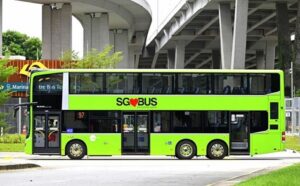Resource Hub
Delivering passenger satisfaction at scale with Headway Management
Published May 26, 2022 in Blog
In our modern ‘on-demand’ world, customer expectations continue to increase for all elements of service delivery. Public Transport Authorities are recognising that asking customers to show up at a time and location determined by the transport authority – when the service cannot arrive on time – conflicts with the principles of modern customer service.
‘Headway Management’ is a proven way to address customer expectations for high-frequency public transport services. This uses available technology to reduce average wait times and increase service reliability, improving the customer experience and building confidence in public transport by removing timetable considerations from journey planning.
 This creates a cultural shift by moving control from transport operators to the passengers.
This creates a cultural shift by moving control from transport operators to the passengers.
With the successful deployment of Trapeze’s Automatic Vehicle Location & Control solution (AVLC), Headway Management is now possible in Australia. Working with Kelsian Group in Sydney Region 6, it’s a truly scalable mechanism for delivering ‘turn up and go’ services – the likes of which we are already seeing in London and Singapore.
With the return of passengers after COVID-19, still underway, we need to do more to encourage the use of, and increase customer confidence with, public transport. There is a high correlation between the realised headways and vehicle capacity utilisations so by decreasing the headway irregularity, you increase the quality of service, and appease the instant gratification culture of customers today.
The bar has been raised
In the “New Normal” of a post Covid world an uptick in working from home has reduced pressure on CBD office space but the roads are as crowded as ever. Passengers are returning to Public Transport, just not to the same degree as before.
We are seeing that innovations such as half price fares in New Zealand result in a significant increase in ridership[1] so we can assume that the fundamentals of PT are good. There has been a lot of innovation with Mobility as a Service (MaaS) trying to deal with the ‘first and last-mile’ problem. However, this innovation is not going to replace trains or buses any time soon. MaaS complements but does not replace traditional mass transport.
UITP have identified that digitalisation of the PT sector is the leading way to win back passengers [2]. This supports our modern ‘on-demand’ world, where customer expectations continue to increase for all elements of public transport service delivery. Asking customers to show up at a time and location determined by the transport authority – when the service they are looking to meet does not arrive on time – conflicts with the principles of modern customer service. A rideshare that picks you up at your home on time and then delivers you to the bus or tram stop where you must wait for 20 minutes, only to have two services arrive at the same time does not meet the needs of modern passengers.
Similarly finishing work at a time that suits, riding an e-bike to the main stop and then waiting 20 minutes for a bus or train isn’t a great experience either.
What is the solution?
Demand-responsive services might well be suited to last mile or regional areas with smaller and more dispersed populations, but they are not suitable for high volume line-haul services.
For these high-capacity services, passengers expect short travel times and quality service. They don’t want to be kept waiting. A recent UK survey confirms this showing that passengers number one priority is that services run more often [3]. One proven way to address these expectations is to consistently deliver high-frequency services, linked by feeder services. A service running every 10 minutes means passengers will only have to wait an average of five minutes. On a busy route, a five-minute service results in a two-and-a-half-minute wait on average. Not only are the services more frequent, but a by-product of the increased frequency is that the buses are less crowded, so passengers have a better-quality journey.
Having set an expectation for a high-frequency route, passengers will factor that into their mobility planning equation. Better optimisation, using real-time data to produce a timetable that caters for traffic variations across the day also helps, but is not enough when real-world events intervene. Increasing service frequency removes much of the passenger delays and widens the mobility options for passengers. The challenge is to maintain that frequency in the face of variable traffic, boarding delays, and life as we know it.
Systemised ‘Headway Management’ of high-frequency bus and tram services is the tool that transport operators use to meet the needs of today’s customers. By using proven, available technology to reduce average wait times and increase service reliability, customer experience and confidence in public transport improves, as timetable considerations are removed from journey planning. Even passenger-friendly features like connection protection are no longer needed, as the arrival frequency is high enough to make connections with ease. We see this in places like the London Underground, or Singapore’s Mass Rapid Transit (MRT), where transfers between lines are routine and are seldom seen as a barrier to using the network. This ‘turn up and go’ approach creates a cultural shift by moving timetable control from transport operators to the passengers.
The key to managing bus headway is to recognise that it is more important to passengers that the service turns up in line with their expectations, rather than the planned travel time is met. In other words, getting onto the bus is a critical task. If you are on a six-minute headway service, then you know that on average, you only have to wait three minutes (and for half the time, it will be less than that). You do not want to wait 10 minutes.

To illustrate, let’s look at a simple three bus scenario with a six-minute headway. If the second service is too close to the first service, then the driver of service two may need to slow down. Slowing down service two may make it too close to service three which will then, in turn, have to slow down to maintain the arrival frequency. From a passenger’s perspective, all this slowing down just means that they only wait for an average of three minutes for any of these services.
Often, it is factors outside a drivers control that cause the initial delays. Heavy traffic is routine, but because we are concerned with arrival frequency and not time, if all the vehicles are delayed the same amount, then passengers’ expectations can be met. To be fair, the passengers waiting for the first bus to get caught in the traffic will experience a delay for that service, but the vast majority of passengers are better off.
One interesting feature is that headway management can be automatically measured and reported on from a passenger’s perspective. So, if a transport authority specifies a six-minute headway for selected routes, then there is a proven way to report on having to wait longer. This is by calculating the Excess Wait Times, also known as EWT reporting. This reporting can be folded into the operator’s performance KPIs and can drive improved performance.
Less glamourous, but just as important is the need for the headway system to communicate with the other mobility solutions. Be it 4G, 5G, DSRC, or other communications, the headway system certainly knows the timetable, but more importantly, it knows when the line-haul is going to be at the stop. Communicating that to the autonomous rideshare, or passengers’ mobile devices allow the connection between these different mobility solutions to become seamless.
Where is Headway used?
Not unsurprisingly, given its power, headway is used to enhance mobility in some of the world’s most mobile cities. London and Singapore both manage their buses on high-frequency routes using headway and EWT reporting. These routes supplement the MRT and the Underground and provide critical line-haul services to people in each city.

A recent pilot of Trapeze’s Automatic Vehicle Location and Control (AVLC) solution in partnership with a major bus operator in a key Australian metropolitan region, has introduced to Australia for the first time, a truly scalable mechanism for delivering ‘turn up and go’ services.
There is a high correlation between the realised headways and vehicle capacity utilisations [6]. By decreasing the headway irregularity, you increase the quality-of-service delivery and appease the instant gratification culture of customers today. A systemised approach is necessary to provide headway services at scale. Increasing confidence in the public transport network is essential to a strong recovery from the pandemic.
Headway solutions enable transport authorities and operators to develop public transport service delivery in line with customer expectations.
Conclusion
Line-haul bus and tram services form a symbiotic relationship with last-mile DRT and mobility solutions. Mobility solutions can be thought of as the capillaries of our transport body carrying passengers around the city with the line haul services as the arteries. Passengers want more frequent line haul services and increased reliability in these services and headway management is the way that transport operators can deliver on this promise. This technology is widespread in London and Singapore and is now in use in Australia and we will quickly see wider adoption of headway as it is shown to deliver that vital heartbeat of regular arrival times at stops.
References
[1] https://www.1news.co.nz/2022/05/09/auckland-public-transport-numbers-highest-since-august-2021/
[2] Win-back-passengers_Final-version-1, UITP, Nov 2021
[3] https://d3cez36w5wymxj.cloudfront.net/wp-content/uploads/sites/8/2020/09/09095433/TF-Bus-passenger-priorities-Sept_20-WEB.pdf
[4] Transport for London, “London’s Bus Contracting and Tendering Process, lbsl-tendering-and-contracting.pdf,” Transport for London, London, 2015.
[5] B. S. C. t. I. S. T. t. BCM, “Bus Services Continue to Improve Since Transition to BCM,” 04 09 2017. [Online].
Available: https://www.lta.gov.sg/apps/news/page.aspx?c=2&id=752cc877-00a8-4e0c-8732-11e3d8ffa126.
[6]“Influence of vehicle headway irregularity in public transport on in-vehicle passenger comfort”, Simeunovic.M et al. Scientific Research and Essays Vol. 7(32), pp. 2874-2881, 2012
Mode of Transport
Bus, Trams/Light Rail, Ferry
Solutions
Intelligent Transport Systems